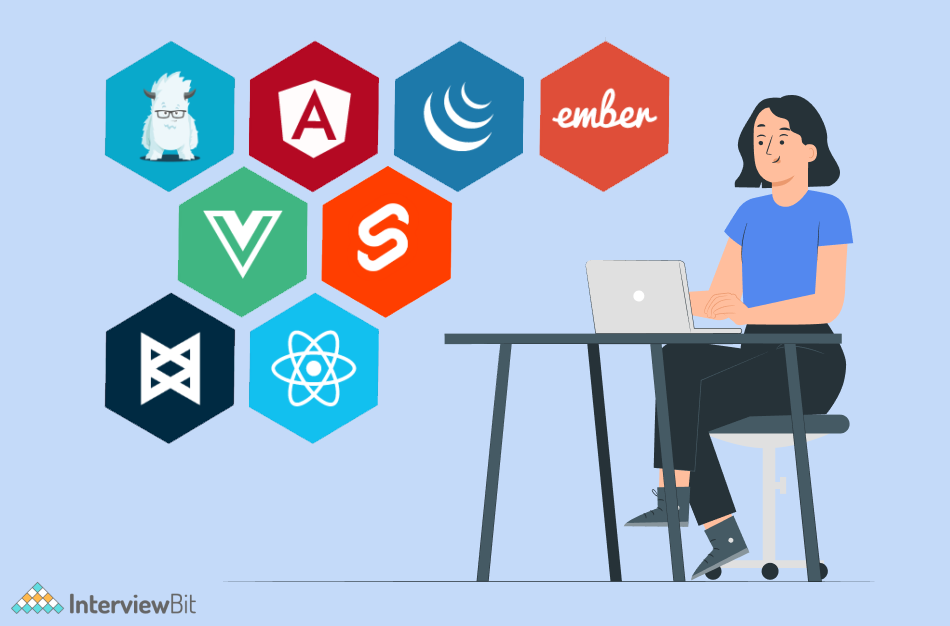Introduction
Front-end development is the development of a web application or a website that a user can interact with. With over 1.8 billion websites powering the World Wide Web and the technical revolution brought in by COVID-19, it is evident that the demand for clean, neat, responsive, precise, and SEO-friendly front end is going to touch new heights in the coming times. No matter how complex functions and operations happen in the background of a website, the user experience has to be seamless and is the topmost priority for all major projects. The seamless operations require the usage of front-end frameworks that streamline the front-end development of interactive, user-centric websites.
In this blog, we will look at top front-end frameworks along with their pros and cons, but before that let’s take a look at what front-end frameworks are and why is there a need to use a front-end framework.
What is Front End Framework?
Front-end framework is a combination of two separate words, Front end + Framework. The front end is the visual site of any web application or website, it is that part of the website with which a user interacts, note that backend is that part that involves API calls, database connectivity, authentication and so on, and a framework in literal sense means an essential supporting structure of an object, the object is a website in this case. Formally, a Framework is a platform for developing applications which provide a foundation on which software applications can be built. So front-end frameworks are the software packages that provide pre-written/reusable code modules standardized front-end technologies and ready-made interface blocks making the process of front-end development a lot faster and simpler. While using a framework, it is possible to create sustainable web applications without the need to code every function or utility from scratch owing to the presence of development instruments in a framework. Most of the front-end frameworks use JavaScript as their source language.
Confused about your next job?
Some examples of Front-end frameworks are React, Vue.js, Angular jQuery etc.
Why Use Front-End Framework
The first question that comes to mind is,
Why use a Framework? Things were going well using plain HTML and CSS as well.
The answer to it is USER EXPERIENCE. When designing a website using HTML-CSS, mostly you will be able to serve static content, you may render some dynamic content as well using JavaScript however the process would be so tedious and repetitive, especially when concerned with the vast number of applications available, to truly rank your product the website should be visually appealing and should focus a lot on user experience, what end-users see and experience has to be seamless.
Take any of the big websites you use on a daily basis, Instagram, Netflix, and GoDaddy, what separates them from the rest is their amazing user experience and sleek user interface. All of them use a Framework for the seamless user experience they provide. Another benefit that you get while using a framework is the ability of the front-end framework to address the scalability issues and the architecture problems that may occur as and when the product grows. Yet another benefit of using a framework is that it reduces the work of developers as they don’t have to write code from scratch, they can directly use the functionality of the framework, So using a framework is a win-win situation for both the developers and the end users, it reduces the work of developers and gives a seamless user experience for the end users.
A common question that sticks in the mind of newbies and sometimes professionals is, which framework do I need to use?
The answer is you can use any framework you like and are versed with, the concern is which one adheres to the requirements, in the following sections we will have a look at top front-end frameworks along with their pros and cons
Best Front-End Frameworks

1. React
Developed and maintained by Facebook, React is one of the best open-source frameworks today and is used by 40.14% of developers as per the StackOverflow developer survey 2021. React was developed to cater to the need for code maintainability issues due to the constant addition of new features in Facebook. It stands out as it provides a Virtual Document Object Model. React is meant to work together with other libraries for state management, routing and API interaction. A general rule of thumb says, to use React when your app is expected to have high traffic and a stable platform is needed to handle it.
Pros of React
- Components in React are reusable in different parts of the application.
- The Virtual DOM gives a consistent and seamless performance.
- New changes can be easily made without breaking the original flow.
Cons of React
- JSX is complex and hard to understand for beginners.
- The React framework undergoes frequent updates so it is difficult to make proper documentation.
When and When not to use React
React is the best option for complex projects that include a number of blocks or components that go through states like variable/binary states, active/inactive states, and active/disabled states. It is recommended not to use React when the developers are not ready to code on pure JavaScript.
Facebook, Netflix, Pinterest, UberEats and many other popular websites use React in the production
2. Angular
Developed and Maintained by Google, Angular is a single framework based on TypeScript. It was formally released in 2016 to bridge the gap between the increasing demands of technology and conventional notions.
The uniqueness of Angular can be attributed to the fact that Angular has a two-way binding feature, Two-way binding gives components in your application a way to share data. Use two-way binding to listen for events and update values simultaneously between parent and child components. There is a real-time synchronization between the model and the view. This means any changes in the model are immediately reflected in the view and vice versa. It deals with the development of mobile and web applications, and can easily build single and multi-page applications as well. Major companies like BMW, Forbes, Xbox use Angular
Pros of Angular
- Real-time model-view synchronization is possible via in-built functionality.
- Developers can make interdependent components of code. The components of code can be decoupled as well using dependency injectors.
- Because of the presence of Directives, developers can play around with document object models and create rich content using HTML.
Cons of Angular
- Angular is quite complex to learn because of its wide variety of features and built-in functionalities.
- It has been observed that dynamic applications built using React can lag sometimes in terms of performance.
When and When not to use Angular
Angular is the best choice for creating large, enterprise-scale applications. It is recommended not to use it when building a simple application with a small team, things may get more complicated then.
Forbes and BMW use Angular
3. Vue.js
Vue.js is one of the most popular simple, straightforward and progressive JavaScript frameworks. It is said that the developers of VueJs have combined the existing front-end frameworks’ best features to develop Vue.js. The framework nicely removes the complexities faced by Angular developers by offering two major advantages, a visual DOM or Document Object Model and component-based programming while offering a 2-way binding. You can build web applications, mobile applications and progressive web applications using Vue.js. Some of the leading corporations like Alibaba, and Xiaomi use Vue.js.
Pros of Vue.js
- The availability of detailed and comprehensive documentation makes it easier to learn.
- Vue.js supports the development of both complex dynamic applications and simple small applications.
Cons of Vue.js
- It is currently in the developing stage so does not have a large community support.
- Most plugins are written in Chinese, so there is a language barrier.
When and When not to use Vue.js
Vue.js is one of the best options when designing a single-page application from scratch as it integrates with the existing server pages along with a wide range of powerful features including bundling and code-splitting. It is recommended not to use Vue.js when building large projects.
Leading corporations like Xiaomi, and Alibaba use Vue.js for their applications.
4. jQuery
The jQuery framework is one of the initial frameworks introduced in 2006. It stands apart in today’s tech ecosphere even today owing to the simplicity it offers, ease to use and the minimal need to write extensive JavaScript codes while using Vue.js. Another major benefit of jQuery is that it is still being continually developed into a better version each passing day. Fundamentally, jQuery is a library that can be used to manipulate CSS and DOM to optimize the functionality and interactivity of a website.
Pros of jQuery
- One of the simplest frameworks, even with very little programming knowledge you can get started with jQuery.
- It can be used to deploy dynamic applications, the components can be easily added or removed due to its flexible DOM.
Cons of jQuery
- Many alternatives for jQuery are available nowadays that perform much better.
- jQuery interface is quite lightweight due to this there may be problems in the longer run.
When and When not to use jQuery
jQuery is used for creating desktop-based JavaScript applications and is a great framework for delivering perfect website interactivity and searchability. It is recommended not to use jQuery when building complex user interfaces as jQuery always accesses the document object model directly which results in slow performance.
Twitter, Microsoft, and SurveyMonkey use jQuery for their projects.
5. Semantic-UI
Jack Lukic invented Semantic-UI and released it in 2014. It is a relative newcomer in the arena of frameworks and is quickly on its way to becoming the most popular front-end framework across the globe. Its objective is to authorize the designers and developers by creating a language for sharing the user interface. The usage of natural language makes the codebase self-explanatory. Semantic-UI is designed for a smooth design of interactive user interfaces.
Pros
- It is one of the latest front-end frameworks offering out-of-box functionality.
- It offers rich UI components
Cons
- Developers using this have to be skilled enough to build custom necessities.
- It is not appropriate for learners that are not skilled in JavaScript.
When and when not to use SemanticUI
SemanticUI, although relatively new as a framework, is quite efficient in delivering an elegant and seamless design of user interfaces. It is recommended not to use it when developers are inexperienced with JS as the developers have to be qualified enough to develop customizations in the applications.
Snapchat, Digital Services and Accenture use SemanticUI.
6. Backbonejs
Backbonejs framework is based on MVC or Model View Controller architecture, MVC architecture View sanctions the execution of the component logic. The collections can be utilized to differentiate the models and allow to building of projects with dissimilar types of users. When developing applications with Backbonejs, you could also use tools like Thorax, Marionette, Chaplin, Handlebars, and more to make the best use of the framework.
Pros
- It is one of the fastest and most lightweight JavaScript frameworks.
- It is quite easy to learn and implement.
Cons
- It delivers uncomplicated tools to produce the app construction and the framework does not offer a handy structure.
- The boilerplate code has to be transcribed.
When and when not to use Backbone Js
It is a good choice for building single-page, small and simple web applications. It can also be used in building large projects as it keeps app logic separated from the user interface. It is recommended to consider some other choices for front-end frameworks as it is decreasing in popularity nowadays.
Uber, Pinterest and Tumbler use it.
8. EmberJs
Ember.js is a productive, battle-tested JavaScript framework for building modern web applications. It includes everything you need to build rich UIs that work on any device.
Ember resembles Angular in terms of component-based functionality and two-way data binding. It was developed in 2011 to handle the growing demands of modern-day technologies. Multifaceted web and mobile applications can be built using ember and its effective design will handle all the concerns. The developer community is trivial despite it being new and unexplored. The framework is quite a challenging web UI framework owing to its conventional and rigid structure.
Pros
- It is a faster development framework and is well-managed.
- It has good documentation.
Cons
- The updates in EmberJS are quite slow and it has a challenging syntax
- It is a substantial framework for smaller apps.
When and when not to use Ember
Ember is a great choice for creating complex and feature-rich single-page web applications for the client side. It is recommended not to use it when working with small projects/teams, it is quite overwhelming as the developers can only operate within a strict context of the features.
Tinder, Apple Music, and LinkedIn use Ember.
Conclusion
This blog discussed important Front-end frameworks.
Feel free to explore the frameworks mentioned above by making projects. Apart from the 8 frameworks explored above, there are plenty of other important and useful frameworks as well, you will get to know them once you start making projects.
Learning by doing is what an aspiring developer must do!!. Since there are many options to choose from among the frontend frameworks, you may be doubtful regarding which framework to choose, in all the cases it is recommended to analyze the problem statement in hand and then choose the right framework for your project.
Besides the already developed frameworks that are spreading their roots deeper in the market, new frameworks are continually developed. So there will always be new choices for your project to learn and work with.
Now we have seen some of the important front-end frameworks, let’s look at some of the frequently asked questions related to the same.
FAQs
Q.1: Is Django a Front-end Framework?
Ans: Django is a collection of Python libs that allows one to quickly and efficiently create a quality Web application, and is suitable for both frontend and backend.
Q.2: Which front-end framework is in demand?
Ans: As per the stack overflow developer survey, React JS is one of the most wanted and desired frameworks. It is the preferred choice as it gives developers the ability to work with virtual DOM.
Q.3: Is React front end?
Ans: React is one of the most used front-end libraries for front-end development.
Q.4: Who uses Front-end Frameworks?
Ans: Front-end frameworks are used by web developers to make sleek, user-friendly user interfaces for the website.







 Join WhatsApp Group
Join WhatsApp Group


